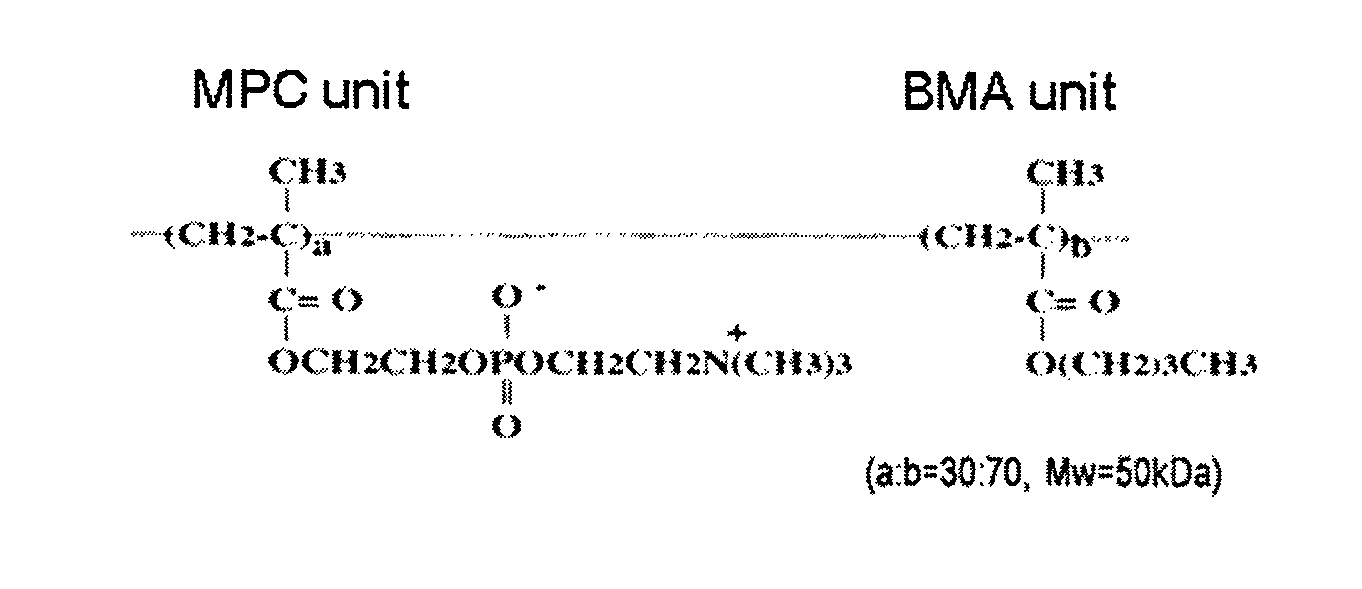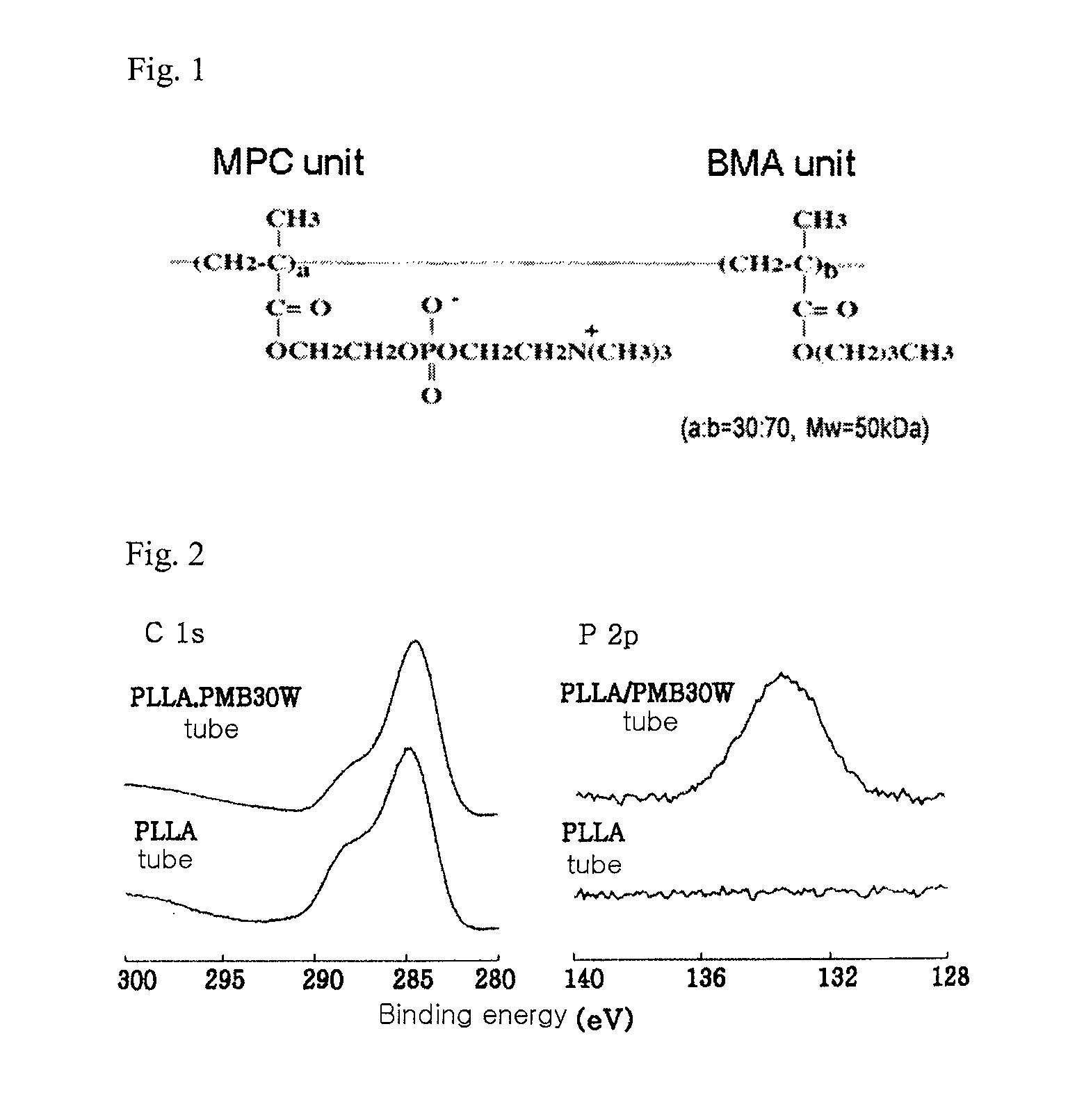Bioabsorbable blend for temporary scaffolding of the blood vessel wall
a bioabsorbable blend and blood vessel wall technology, which is applied in the field of bioabsorbable blends of poly (llactide) and phosphorylcholine groupcontaining copolymers, can solve the problems of ineffective conventional coating of the platform with ppcp, myocardial infarction or sudden cardiac death, etc., and achieves stable biodegradation patterns, high density of phosphorylcholine groups, and strong breaking strength
- Summary
- Abstract
- Description
- Claims
- Application Information
AI Technical Summary
Benefits of technology
Problems solved by technology
Method used
Image
Examples
example 1
Preparation of PLLA / PMB30W Blends
[0049]High-molecular-weight PLLA (Mw=100 kDa) and low-molecular-weight PLLA (sPLLA; Mw=2 kDa) were obtained from Polysciences. Water-soluble amphiphilic PMB30W (Mw=50 kDa) was synthesized from an MPC unit and a BMA unit at a ratio of 3 to 7. The chemical structure of PMB30W is shown in FIG. 1. A 6 wt % PLLA polymer solution in dichloromethane, PLLA / PMB30W (95 / 5, wt / wt) blend polymer solution in dichloromethane and methanol (12 / 1, v / v), and PLLA / PMB30W (90 / 10, wt / wt) blend polymer solution in dichloromethane and methanol (12 / 1, v / v) were prepared, followed by sufficient stirring of the solutions until they became transparent. The solutions were sonicated in a cold bath with ice for 30 min for homogenization.
example 2
Fabrication of PLLA / PMB30W Cast Films and Tubes
[0050]To fabricate cast films, the polymer solutions were cast onto Teflon dishes, and the solvents were dried overnight at room temperature.
[0051]The PLLA polymer solution was dip-coated on Teflon rods of 1.6-4.0 mm diameter to fabricate small and large tubes, respectively. The large tubes were processed only for XPS surface analysis and blood contact testing. The solvent was evaporated from the Teflon rods by rotating at 70-80 rpm for 1 h at room temperature. This process was repeated 7-8 times to fabricate a small tube having an outer diameter of 2.0 mm.
[0052]The PLLA / PMB30W (95 / 5, wt / wt) blend polymer solution was dip-coated on Teflon rods of 1.6-4.0 mm in diameter. The solvent was evaporated from the Teflon rods by rotating at 70-80 rpm for 1 h at room temperature. This process was repeated 9 times to fabricate a thick polymer membrane acting as a mechanical supporting layer of the PLLA / PMB30W tube. Subsequently, the PLLA / PMB30W (9...
example 3
Methods for Determining the Properties of PLLA / PMB30W Blends
[0053](Morphology)
[0054]The samples were subjected to gold sputtering, followed by observation of the surface morphologies under a scanning electron microscope (SEM; SM-200; Topcon, Japan).
[0055](Mechanical Properties)
[0056]The cast films were cut into barbell-shaped films (44.5 mm×2.5 mm). The breaking strength and Young's modulus of the barbell-shaped cast films were measured with a strength tester (STA-1150; Orientec, Japan). The crosshead speed was 10 mm / min.
[0057](Surface Analysis)
[0058]A large PLLA / PMB30W tube was cut into concave membranes before the removal of residual solvents. To fabricate flat membranes, the concave membranes were pressed by applying a pressure of 10 MPa at 60° C. for 10 min. After removing the residual solvents, the flat membranes were incubated with phosphate-buffered saline (PBS) at 36.7° C. in a shaking bath at 80-100 rpm. The flat membranes were then sufficiently rinsed with distilled water ...
PUM
| Property | Measurement | Unit |
|---|---|---|
| outer diameter | aaaaa | aaaaa |
| temperature | aaaaa | aaaaa |
| speed | aaaaa | aaaaa |
Abstract
Description
Claims
Application Information
 Login to View More
Login to View More - R&D
- Intellectual Property
- Life Sciences
- Materials
- Tech Scout
- Unparalleled Data Quality
- Higher Quality Content
- 60% Fewer Hallucinations
Browse by: Latest US Patents, China's latest patents, Technical Efficacy Thesaurus, Application Domain, Technology Topic, Popular Technical Reports.
© 2025 PatSnap. All rights reserved.Legal|Privacy policy|Modern Slavery Act Transparency Statement|Sitemap|About US| Contact US: help@patsnap.com



